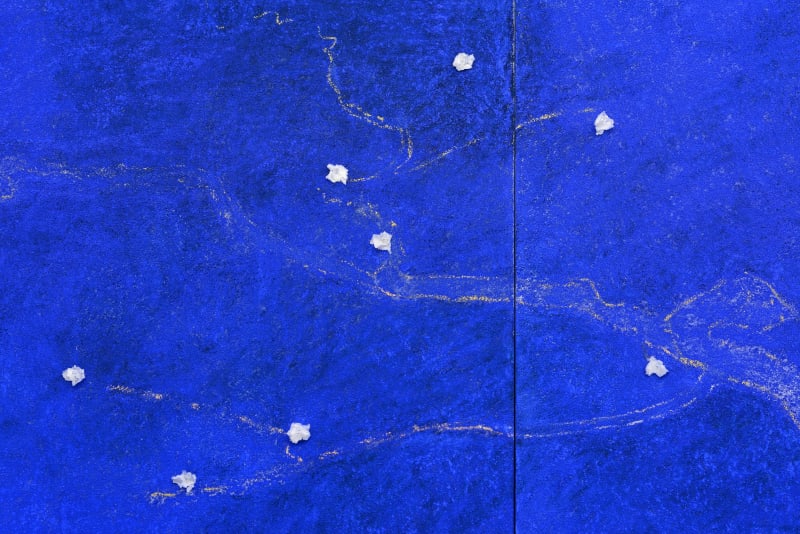At age 79, Italian artist Pier Paolo Calzolari continues to be inspired by the poetic and the alchemical potentials of art. The artist, who was born in Bologna in 1943, was one of the seminal figures of the Arte Povera movement of the late 1960s. Now living in Lisbon, Calzolari has recently opened “Painting as a Butterfly,” a major survey of paintings at Marianne Boesky Gallery, and the artist’s fourth solo exhibition with the gallery.
Spanning both of the gallery’s Chelsea spaces, the exhibition marks Calzolari’s first solo show in the U.S. since 2017, and features more than 30 paintings made over the past four years. Many of the works on view were made during the pandemic and tap into a longing for human connection.
The ongoing series “Shop Signs”, which Calzolari started in 2019, are hung, salon-style, in the gallery, creating an imagined walk past the shops of the artist’s native Marche Valley village in Italy. Alongside these new works, the exhibition also presents two of the artist’s older, monumental paintings—Monocromo Blue (Blue Monochrome)and Rideau V—which are loaned from Fondazione Calzolari and a private Italian collection, respectively—are being shown in the U.S. for the first time.
Many of these works are focused on the wonders of the natural world, with Calzolari incorporating salt, feathers, clover petals, and seashells into his canvases, and working with raw pigment powders and tempera to create startlingly saturated colors.
“Calzolari’s paintings are performative and poetic,” Marianne Boesky said. “ In these new works, the artist is returning to raw pigments in vibrant reds, blues, and yellows with an unexpected exuberance after several decades. This exhibition reflects a kind of laser-focused energy that might only have been possible in quarantine.”
We asked Calzolari about the inspirations behind his new paintings.
The exhibition includes 30 paintings made over the past four years. Did your process or mindset shift over quarantine?
Of course. Around me, I felt real yet insidious and hidden ghosts and nightmares preying on my most familiar demons. I think of a title of one of my artworks: “Wolves and fireflies.” Try to think of what it is to be a wolf and a pack of wolves, and try to think of the thousands of lights flying around you. Therein is part of the answer.
What does a painting “as a Butterfly” look like or feel like? What does the title conjure?
Fly, my friend, let your wings flutter! And you will have the answer.
The “Shop Signs” series speaks to the absence of daily rituals. Your work is often inspired by personal memory. During quarantine, what memories were coming to you most often? What did you miss the most?
The dream is fantasizing instead of having nightmares or being in a state of suspicion towards the world. The “Shop Signs” are born from ancient dreams: to be sitting at night, back inside a medieval wagon of a theatre company and watching the starry sky. I imagined arriving in a country and offering my services as a sign illustrator before the show.
Everything was born from a dinner with Marcello Mastroianni, the revered film star. He told me: “I remain a poor comedian of the theatre of art.” Since then, I have had a continuous dream. I imagined myself as a comedian/scenographer/painter, sitting behind the wagons pulled by horses, looking at the moon. I arrived in various countries, running to all the shops—taverns, sellers of hats, shoes, bricklayers, and so on. Here is the romantic dream that chased me and led me to make all these paintings that I am presenting.
Why did you decide to include older works in an exhibition with new works?
Dreams last a long time and accompany you till the end.
What’s the role of color in these new paintings? I know these canvases include raw pigment powders and tempera in startlingly saturated colors or vibrant reds, blues, and yellows. Why did you choose to incorporate these materials?
For those who know my story, it’s obvious that I’ve always been “listening.” The purity of the elements, the pure allure of light that is white, the absoluteness of salt, the luminosity of absolute black, the blindness of burnt wood, and the purity of every raw and primary pigment.
What place do you think these new paintings have in your career?
The alchemical, shamanic power—a primary and ancient power—is the physicality of a dream. As stated in works I made in my previous New York exhibition from 2012: “When the dreamer dies what happens to the dream?”


